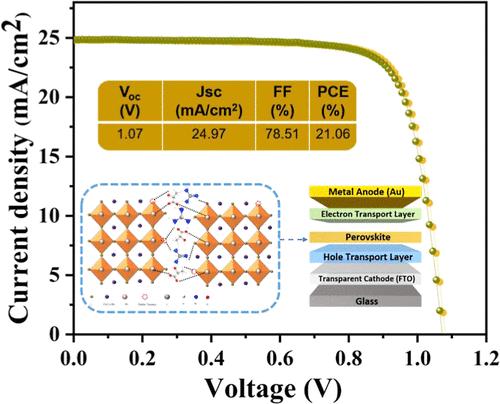Multifunctional Guanidine Ionic Liquid with Lactate Anion-Assisted Crystallization and Defect Passivation for High-Efficient and Stable Perovskite Solar Cells
IF 5.4
3区 材料科学
Q2 CHEMISTRY, PHYSICAL
引用次数: 0
Abstract
Perovskite solar cells (PSCs) are receiving tremendous attention among other photovoltaic devices for their high power conversion efficiency (PCE), facile fabrication technique, eco-friendliness, and low cost. Unfortunately, the intrinsic defects and the quality of the perovskite films arising from the halide ion migration and undercoordinated Pb2+ are still considered to be the bottleneck for long-term operational stability. Herein, the introduction of task-specific ionic liquid (IL) tetramethylguanidine lactate (GuLAC) demonstrates excellent defect passivation effects and crystal growth. More specifically, the formation of hydrogen bonds between –NH2 in GA+ and I– passivates cation defects, while strong chemical interaction of lactate anion passivates the undercoordinated Pb2+. Both experimental observations and theoretical simulation confirm the strong interaction of GuLAC with the perovskite, which is responsible for restricting ion migration, improving grains’ size, and elongating the carrier lifetime. As a result, the IL-modified device exhibits improved PCE and superior long-term stability compared to the control device. The incorporation of IL additives proves to be a viable approach for achieving both high PCE and stable PSC devices.

乳酸阴离子辅助结晶和缺陷钝化的多功能胍离子液体,用于高效稳定的 Perovskite 太阳能电池
在其他光电设备中,过氧化物太阳能电池(PSCs)因其高功率转换效率(PCE)、简便的制造技术、环保性和低成本而备受关注。遗憾的是,由于卤离子迁移和 Pb2+ 配位不足而导致的过氧化物薄膜的内在缺陷和质量问题仍被认为是影响其长期运行稳定性的瓶颈。在本文中,引入特定任务离子液体(IL)四甲基胍乳酸盐(GuLAC)显示出卓越的缺陷钝化效果和晶体生长。更具体地说,GA+中的-NH2与I-之间形成的氢键钝化了阳离子缺陷,而乳酸阴离子的强化学作用钝化了配位不足的Pb2+。实验观察和理论模拟都证实了 GuLAC 与包晶的强相互作用,这种作用限制了离子迁移,改善了晶粒尺寸,延长了载流子寿命。因此,与对照器件相比,IL 改性器件显示出更好的 PCE 和更出色的长期稳定性。事实证明,加入 IL 添加剂是实现高 PCE 和稳定 PSC 器件的可行方法。
本文章由计算机程序翻译,如有差异,请以英文原文为准。
求助全文
约1分钟内获得全文
求助全文
来源期刊

ACS Applied Energy Materials
Materials Science-Materials Chemistry
CiteScore
10.30
自引率
6.20%
发文量
1368
期刊介绍:
ACS Applied Energy Materials is an interdisciplinary journal publishing original research covering all aspects of materials, engineering, chemistry, physics and biology relevant to energy conversion and storage. The journal is devoted to reports of new and original experimental and theoretical research of an applied nature that integrate knowledge in the areas of materials, engineering, physics, bioscience, and chemistry into important energy applications.
 求助内容:
求助内容: 应助结果提醒方式:
应助结果提醒方式:


